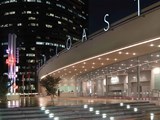By SCR Staff
In a Digital World, the Basics of Theatre Remain the Same
Even though the pandemic has brought changes to how you currently watch a play—like the digital production of Red Riding Hood adapted by Allison Gregory—the basics of theatre remain the same. Our stories continue to be brought to life complete with sets, lights, costumes and sound. And we still have rehearsals (modified with safety protocols), block scenes, create props, call cues and more. [Parents & Teachers: Check out our theatre vocabulary below to share more about these and other terms.]
“When you design for the theatre, you know that the audience will see the whole stage,” says Red Riding Hood Director Shannon Flynn. “For this show, the design team and I had to think about what we’d be able to see through the camera lens. Just before we filmed on the Segerstrom Stage, I stood at every point where the camera would be, to make sure that we had the best angles.”
Red Riding Hood had a team working in front of the camera (actors Larry Bates and Nell Geisslinger) and behind-the-scenes (such as the playwright, director stage manager, artisans and others).
“One of the joys of being in theatre is the 'family' of people that brings the show to life,” says Geisslinger. “And I think that’s what the characters in Red Riding Hood discover in each other by the end of the play.”
Test Your Knowledge of Basic Theatre Terms
- Backstage The space behind the acting area, unseen by the audience.
- Blocking The movement onstage designed by the director and performed by the actors.
- Choreography The art of creating and arranging dances onstage.
- Cue The last words or action of an actor immediately preceding the lines or business of another actor.
- Downstage The part of the stage closest to the audience. At one time, stages were raked, or sloped, with the lower (“down”) part closest to the audience, and the higher (“up”) part farther away.
- Props All the hand-held items and stage furnishings, including furniture, that are physically used by the actors.
- Rehearsal Time used by performers to practice privately before a performance in front of an audience.
- Script The text of the play, including dialogue and stage directions, all written by the playwright.
- Upstage The area of the stage farthest away from the audience and nearest to the back wall.


